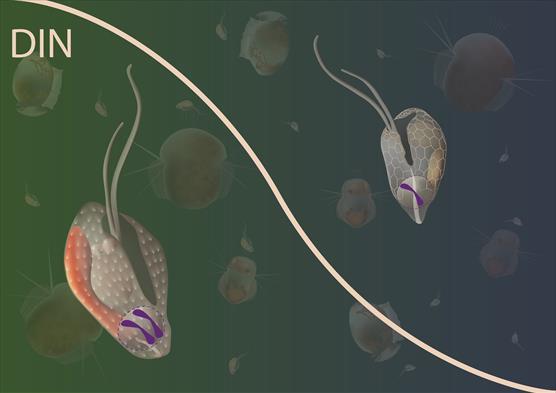
The microalgae Teleaulax amphioxeia changes its reproduction pattern from asexual to sexual reproduction as nitrogen availability (DIN) drops. In winter with high N it has paired DNA, but under N scarcity it has only one set of chromosomes. The cells in the foreground represent the diploid Teleaulax amphioxeia (left) and the haploid Plagioselmis stage of Teleaulax amphioxeia (right). In the background are these two life cycle stages shown together with their predators Dinopysis acuminata, Mesodinium rubrum, and Mesodinium major to scale.
© Illustration: Sofie Binzer
There are hundreds of different species of microscopic algae in our seas and oceans. These single-celled organisms are responsible for the production of approximately 50% off all the oxygen that is generated through photosynthesis on this planet. Microscopic algae in the oceans fix 50% of carbon dioxide on the planet. Despite the huge significance of these algae, we still know very little about their life and survival strategies, for example nutritional habits and reproduction.
Sexual reproduction instead of binary division
The tiny single-celled algae are traditionally thought to reproduce simply by asexual cell division and produce clones, which restricts their genetic diversity and capacity for adaptation in changing environmental conditions.
Now, for the first time, marine scientists found that sexual reproduction – change from diploid DNA to haploid – happens in single-celled algae when their growth becomes limited by resources, in this case availability of nitrogen. This survival strategy may be much more common among the unicellular algae than previously thought.
The great discovery happened by accident
One day in February 2017 Lumi Haraguchi, then a PhD student at Aarhus university in Denmark, looked at her cultures of algae that were left unattended for some time. She was surprised to see that the cells were alive but apparently changed from one species to another. She initially thought her culture had been contaminated, but as it happened again in even more controlled conditions, Lumi speculated that the two different types of algae cells were actually same species but represented different life cycle stages.
The hypothesis was later confirmed in the nature, and by analyzing the DNA of these two common Cryptophyte species Teleaulax amphioxeia and Plagioselmis prolonga. Whereas one “species” had a single set of chromosomes (so-called haploid) which we know from the eggs and spermia of higher organisms, the other was an organism with two sets of chromosomes (diploid) as found in animals and plants.
This study points out our limited knowledge of many organisms living in seas and functioning of the marine ecosystems.
Lumi Haraguchi’s current research activities in the Marine Research Centre of the Finnish Environment Institute in project SEASINK (funded by the Academy of Finland) focus on very similar topic: the functioning of phytoplankton communities and their role in oceanic CO2 fluxes.
The study Dimorphism in cryptophytes—The case of Teleaulax amphioxeia/Plagioselmis prolonga and its ecological implications has now been published in the prestigious scientific journal, Science Advances.
More information:
Recearcher Lumi Haraguchi, Finnish Environment Institute (Marine Ecological Research Laboratory), tel. +358 295 252 038, e-mail: firstname.lastname@ymparisto.fi
FINMARI consortium manager Pirjo Kuuppo, Finnish Environment Institute (Marine Ecological Research Laboratory), tel. +358 295 252 192, e-mail: firstname.lastname@ymparisto.fi